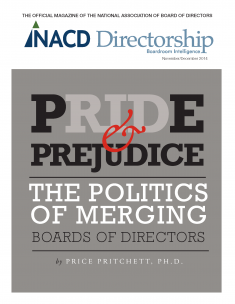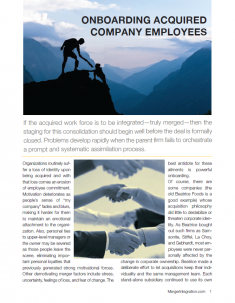Some 200 years ago, Jane Austen—one of Britain’s best-loved authors—wrote a famous novel about marrying. And money. Deep down that’s actually what mergers are about, too, so I thought to myself, “Maybe her classic, Pride and Prejudice, has parallels for merger integration.”
After all, “corporate marriage” is the most common metaphor used when people talk about combining two companies. And as for the part about money, well, M&A is always based on a financial proposition.
Since Austen’s story about 18th century England focuses on social class, let’s look at merger integration from that angle. In the hierarchy of power and status, the Board of Directors is the uppermost class…the top rung of the corporate social ladder…the highest level of governance.
So how do pride and prejudice affect the integration process in boardroom society?
Merging Begins at the Board Level
Actually very little has been written about the wedding of boards when companies marry. This is peculiar, given the importance of directors and the fact that boards are at the front of the line for integration.
Merging is ordinarily a top-down process. Directors go first. They’re the top link in the chain of command, and the makeup of the merger’s new leadership structure needs to be resolved as quickly as possible. Urgency in blending the two boards into one means this elite crowd will be among the first to feel three highly predictable dynamics triggered by a merger:
- A sharp increase in ambiguity and uncertainty
- A drop in the trust level
- Arousal of instincts for self-preservation
These are natural human responses. When change hits, the first scan is for danger. And as the playwright John Dryden stated, “Self-preservation is Nature’s oldest law.”
We can hope that directors will be selfless and statesmanlike as the board gets reconfigured, but let’s not presume that they are Vulcans. These power brokers fall prey to the very same “me issues” that will bedevil the entire workforce as the integration process unfolds. Incumbent board members wonder, “Will I get to keep my directorship? How might my role on the board change? What will happen to my compensation?” And so on.
These concerns make perfect sense. Since board personnel are the first batch of people facing consolidation in the merger, some will be the first victims of redundancy.
Pride Cometh
Integration is a politically sensitive process at all levels of an organization, but especially so in the rarified air of the boardroom. Pride is more easily bruised at this altitude.
After all, directorships are a badge of honor—ego gratifying, high octane fuel for one’s self-esteem. People who occupy these positions often covet the prestige more than any monetary rewards that come with a board appointment. Some find that the power carries the most appeal. Some put more value on the business connections that come with the job. Some prize most the upper crust coolness of being in a network of celebrity names.
Of course, there are other perhaps more noble psychic rewards, such as the intellectual challenge, an opportunity to contribute, or a chance to learn and broaden one’s self through board work. But regardless of how directors weigh the rewards as individuals, those who lose out in the board shakeup get their egos banged up a bit in the process.
So, does this matter? Why worry about someone’s potential for injured pride? Well, as folk wisdom says, “Wounded animals are dangerous.”
Merging Creates a More Complicated Agenda
At the very time directors naturally become more self-oriented, their workload becomes more complex. This is a particularly troubling situation because board effectiveness needs to be at its peak.
Let’s consider the new hazards.
First, merging introduces a fresh set of risk factors, a more vulnerable time for the business. Also the board’s workload ratchets up and intensifies. Priorities shift. The company comes under much sharper scrutiny by shareholders and the media. The competition circles, trying to take advantage of the situation. Directors must address a broad range of heavy-duty considerations regarding strategy, culture, operating style, financial pressures, etc.
Meanwhile, the board itself is being reconfigured, which causes distraction and a regression in teamwork. The crossbreeding process in merging the two boards involves new assignments for directors, changes in the pecking order, and adjustments to new personalities.
Trust is the grease that lubricates directors’ ability to guide and govern the new combined entity through the hazards of merger integration. But the trust level in the boardroom dips sharply in the face of these assimilation challenges.
The Clint Eastwood Observation
The movie star and former mayor of Carmel points out the danger here in his remark:
“The less secure a man is, the more likely he is to have extreme prejudice.”
Taking that statement to heart, we should expect that directors will become more influenced by their personal biases as dealmakers finalize the merger. And it’s reasonable to believe their thinking will rely more heavily on preconceived notions.
Obviously, as Eastwood suggests, this dilemma of slanted mindset can hijack directors’ objectivity. The natural result? More prejudicial problem-solving and decision-making threads its way into boardroom behavior. There’s an impulse to think, “Our company’s way is better”…”Our people are more capable”…”Our sense of what should happen is best.”
Ordinarily, these are honest points of view, even as they can be entirely wrong. Directors may be struggling to be fair minded and dispassionate. They might wish to analyze circumstances from a position of neutrality and probably would argue that they do. But such an intention and desire hardly guarantee success. Human behavior is what it is, the psychology of self-defense runs deep, and our prejudices deceive us all too easily.
Protecting the Board from Human Nature
There are, however, practical steps that can defend the board of directors against the political effects of pride and prejudice. Let’s keep it simple here, focusing on what I’ll call the minimum effective dose (MED) for dealing with board transitions during a merger.
MED is defined as the smallest dose that will produce a desired outcome. The MED not only delivers the most dramatic results, but it does so in the least time possible. Certainly more can be done, but more is not necessarily better—often greater dosages are wasteful. Maybe damaging.
Here are three of the most constructive moves you can make:
-
Bring outsiders onto the board right out of the gate. This means you need to leave some seats open, rather than stack the new board full of legacy directors from the two organizations.
It may seem counterintuitive, but odds are your newly configured board will coalesce quicker and be more effective with brand new directors in the mix.
-
Disregard the urge for pro rata board representation. You might feel pressure to allot directorships on a proportional basis, but board seats should not be dictated by the respective sizes of the two merging firms.
For example, companies of near equal size often feel obligated to go 50-50, following that seemingly equitable practice of giving half of the directorships to each company. But look at it this way—if you were merging the Pittsburgh Steelers with the Dallas Cowboys, would it ever enter your mind to insist that half of your new offensive and defensive teams had to come from each organization? Not a chance. You’d go for talent, not for surface appearances. And you wouldn’t compromise the new team’s future by making some feeble attempt at parity for purely political reasons.
Look—merging offers a prime opportunity to strengthen your board. Seize the moment. Use the shakeup to replace weaker directors. Your new slate of board members immediately faces greater challenges and must govern the company at its suddenly enlarged level. Presumably, the merger created a stronger business. Does it not deserve a stronger board?
-
Use an expert board facilitator, an outside consultant, to advise and guide the board into the transition. Such a person, with deep knowhow and no axe to grind, can make a huge contribution in the merging process at this highest level of governance.
This professional can immediately improve the board’s ability to—
- Make decisions as a group
- Be a unified voice
- Operate with role clarity
- Work through philosophical divides
Assuming that you adhere to these minimalistic guidelines, will merging two boards into one remain a sensitive, highly political process? Absolutely. That’s the nature of the beast. But these three practices alone go a long way toward positioning your new director group for merger success.
What Counts Most is How the Story Ends
Pride and Prejudice, like other Jane Austen books, has a happy ending. The main characters overcome their personal struggles and love wins out. The marriage works.
But a large percentage of corporate weddings end badly. While the reasons vary, many of these merger disappointments could be avoided through better governance by the board of directors. Remember—that’s where the integration process begins.
Having been involved in M&A now for some 40 years, I know the habits of CEOs and board chairmen. And the fact is they’re disinclined to follow the minimum effective dose prescription outlined above. To be honest, I understand why. The politics of integration are delicate indeed.
Here’s the irony: While it’s quite rare for merging boards to take the three steps that are recommended, it’s remarkably common for them to say they wish they had.





